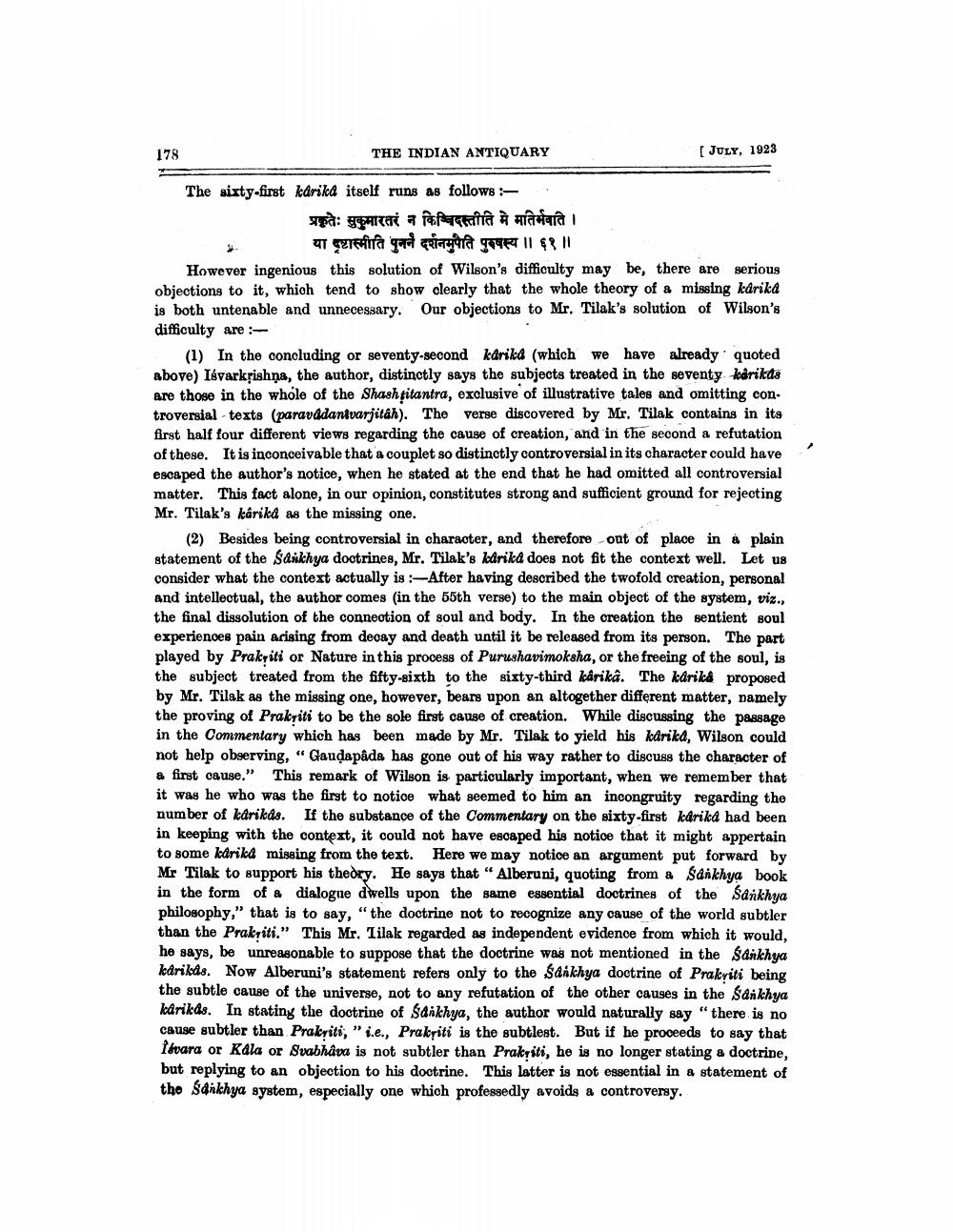________________
178
THE INDIAN ANTIQUARY
( JULY, 1923
The sixty-first karika itself runs as follows :
प्रकृतेः सुकुमारतरं न किञ्चिदस्तीति मे मतिर्मवति ।
या दृष्टास्मीति पुनर्न दर्शनमुपैति पुरुषस्य ।। ६१ ॥ However ingenious this solution of Wilson's difficulty may be, there are serious objections to it, which tend to show clearly that the whole theory of a missing kdrika is both untenable and unnecessary. Our objections to Mr. Tilak's solution of Wilson's difficulty are :
(1) In the concluding or seventy-second karika (which we have already quoted above) Isvarkrishna, the author, distinctly says the subjects treated in the seventy karikas are those in the whole of the Shashtitantra, exclusive of illustrative tales and omitting con. troversial texts (paravadantvarjitah). The verse discovered by Mr. Tilak contains in its first half four different views regarding the cause of creation, and in the second a refutation of these. It is inconceivable that a couplet so distinctly controversial in its character could have escaped the author's notice, when he stated at the end that he had omitted all controversial matter. This fact alone, in our opinion, constitutes strong and sufficient ground for rejecting Mr. Tilak's kariká as the missing one.
(2) Besides being controversial in character, and therefore out of place in a plain statement of the Sankhya dootrines, Mr. Tilak's kdrikd does not fit the context well. Let us consider what the context actually is -After having described the twofold creation, personal and intellectual, the author comes (in the 55th verse) to the main object of the system, viz., the final dissolution of the connection of soul and body. In the creation the sentient soul experiences pain arising from decay and death until it be released from its person. The part played by Prakriti or Nature in this process of Purushavimoksha, or the freeing of the soul, is the subject treated from the fifty-sixth to the sixty-third karikâ. The kariká proposed by Mr. Tilak as the missing one, however, bears upon an altogether different matter, namely the proving of Prakriti to be the sole first cause of creation. While discussing the passage in the Commentary which has been made by Mr. Tilak to yield his karika, Wilson could not help observing, “ Gauda pada has gone out of his way rather to discuss the character of a first cause." This remark of Wilson is particularly important, when we remember that it was he who was the first to notice what seemed to him an incongruity regarding the number of karikas. If the substance of the Commentary on the sixty-first karika had been in keeping with the context, it could not have escaped his notioe that it might appertain to some kdrikd missing from the text. Here we may notice an argument put forward by Mr Tilak to support his theory. He says that “Alberuni, quoting from a Sankhya book in the form of a dialogue dwells upon the same essential doctrines of the Sankhya philosophy," that is to say, "the doctrine not to recognize any cause of the world subtler than the Prakriti." This Mr. Tilak regarded as independent evidence from which it would, he says, be unreasonable to suppose that the doctrine was not mentioned in the sankhya kdrikds. Now Alberuni's statement refers only to the Sankhya doctrine of Prakyiti being the subtle cause of the universe, not to any refutation of the other causes in the Sankhya karikds. In stating the doctrine of Sankhya, the author would naturally say "there is no cause subtler than Prakriti, " i.e., Prakriti is the subtlest. But if he proceeds to say that Isvara or Kala or Svabhava is not subtler than Prakriti, he is no longer stating a doctrine, but replying to an objection to his doctrine. This latter is not essential in a statement of the Sankhya system, especially one which professedly avoids a controversy.




